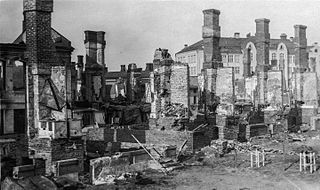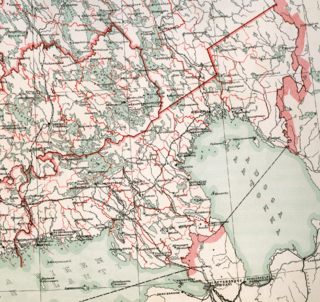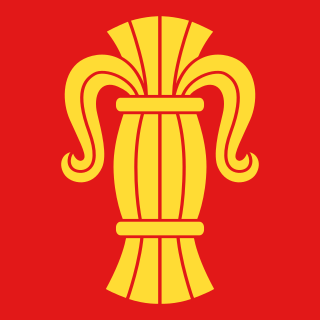
Finland, officially the Republic of Finland, is a Nordic country in Northern Europe. It shares land borders with Sweden to the northwest, Norway to the north, and Russia to the east, with the Gulf of Bothnia to the west and the Gulf of Finland across Estonia to the south. Finland covers an area of 338,455 square kilometres (130,678 sq mi) with a population of 5.6 million. Helsinki is the capital and largest city, forming a larger metropolitan area with the neighbouring cities of Espoo, Kauniainen, and Vantaa. The vast majority of the population are ethnic Finns; Finnish, alongside Swedish, are the official languages. Finland's climate varies from humid continental in the south to the boreal in the north. The land cover is primarily a boreal forest biome, with more than 180,000 recorded lakes.

The Finnish Civil War was a civil war in Finland in 1918 fought for the leadership and control of the country between White Finland and the Finnish Socialist Workers' Republic during the country's transition from a grand duchy of the Russian Empire to an independent state. The clashes took place in the context of the national, political, and social turmoil caused by World War I in Europe. The war was fought between the "Reds", led by a section of the Social Democratic Party, and the "Whites", conducted by the conservative-based senate and the German Imperial Army. The paramilitary Red Guards, which were composed of industrial and agrarian workers, controlled the cities and industrial centers of southern Finland. The paramilitary White Guards, which consisted of land owners and those in the middle- and upper-classes, controlled rural central and northern Finland, and were led by General C. G. E. Mannerheim.

Helsinki is the capital, primate, and most populous city of Finland. Located on the shore of the Gulf of Finland, it is the seat of the region of Uusimaa in southern Finland, and has a population of 658,864. The city's urban area has a population of 1,268,296, making it by far the most populous urban area in Finland as well as the country's most important center for politics, education, finance, culture, and research; while Tampere in the Pirkanmaa region, located 179 kilometres (111 mi) to the north from Helsinki, is the second largest urban area in Finland. Helsinki is located 80 kilometres (50 mi) north of Tallinn, Estonia, 400 km (250 mi) east of Stockholm, Sweden, and 300 km (190 mi) west of Saint Petersburg, Russia. It has close historical ties with these three cities.

Baron Carl Gustaf Emil Mannerheim was a Finnish military leader and statesman. He served as the military leader of the Whites in the Finnish Civil War of 1918, as Regent of Finland (1918–1919), as commander-in-chief of Finland's defence forces during the period of World War II (1939–1945), as Marshal of Finland (1942–), and as the sixth president of Finland (1944–1946).

The prime minister of Finland is the leader of the Finnish Government. The prime minister and their cabinet exercise executive authority in the state. The prime minister is formally ranked third in the protocol after the president of Finland and the speaker of the Parliament. Finland's first prime minister was Pehr Evind Svinhufvud, was appointed on 27 November 1917, just a few days before the country declared independence from Russia.

The Senate of Finland combined the functions of cabinet and supreme court in the Grand Duchy of Finland from 1816 to 1917 and in the independent Finland from 1917 to 1918.

Kuressaare is a town on Saaremaa island in Estonia. It is the administrative centre of Saaremaa Parish and the capital of Saare County. Kuressaare is the westernmost town in Estonia. The recorded population on 1 January 2018 was 13,276.

The policy of Russification of Finland was a governmental policy of the Russian Empire aimed at limiting the special status of the Grand Duchy of Finland and possibly the termination of its political autonomy and cultural uniqueness in 1899–1905 and in 1908–1917. It was a part of a larger policy of Russification pursued by late 19th–early 20th century Russian governments which tried to abolish cultural and administrative autonomy of non-Russian minorities within the empire.
Grand Duke of Finland, or, more accurately, the Grand Prince of Finland, was, from around 1580 to 1809, a title in use by most Swedish monarchs. Between 1809 and 1917, it was the official title of the ruler of the autonomous Grand Principality of Finland, who was also the Emperor of Russia. The anachronistic female form of the title in English would be Grand Duchess of Finland. The only women to have used the title were the Swedish queens regnant Kristina and Ulrika Eleonora. A few crown princes of Sweden also were called Grand Duke of Finland.

The Grand Duchy of Finland was the predecessor state of modern Finland. It existed between 1809 and 1917 as an autonomous part of the Russian Empire.
Finland's Independence Day is a national public holiday, and a flag flying day, held on 6 December to celebrate Finland's declaration of independence from the Russian Empire when the Bolsheviks took power in late 1917.

The Finnish National Theatre, established in 1872, is a theatre located in central Helsinki on the northern side of the Helsinki Central Railway Station Square. The Finnish National Theatre is the oldest Finnish speaking professional theatre in Finland. It was known as the Finnish Theatre until 1902, when it was renamed the Finnish National Theatre.

The Finnish cinema has a long history, with the first public screenings starting almost as early as modern motion picture technology was invented. It took over a decade before the first Finnish film was produced and screened in 1907. After these first steps of Finnish cinema, the progress was very slow. After 1907 there were two periods when no Finnish films were produced. This was partly caused by the political situation, as Finland held a status as an autonomous part of the Russian Empire and was thus influenced by the worldwide political situation.

The Viipuri Province was a historical province of Finland from 1812 to 1945.
The following outline is provided as an overview of and topical guide to World War I:

Vyborg is a town in, and the administrative center of, Vyborgsky District in Leningrad Oblast, Russia. It lies on the Karelian Isthmus near the head of the Vyborg Bay, 130 km to the northwest of St. Petersburg, 245 km east of the Finnish capital Helsinki, and 38 km south of Russia's border with Finland, where the Saimaa Canal enters the Gulf of Finland. The population of Vyborg is as follows: 79,962 (2010 Census); 79,224 (2002 Census); 80,924 (1989 Census).

Vaasa, in the years 1855–1917 as Nikolainkaupunki, is a city on the west coast of Finland. It received its charter in 1606, during the reign of Charles IX of Sweden and is named after the Royal House of Vasa. Vaasa has a population of 67,631, and is the regional capital of Ostrobothnia. Vaasa is also well-known as a major university and college city in Finland.

Trust is a 1976 Finnish-Soviet historical drama film directed by Edvin Laine and Viktor Tregubovich. The film portrays the events leading up to the Finnish Declaration of Independence from Russia in 1917 and especially the role of Soviet leader Vladimir Lenin in them. The main roles are played by Kirill Lavrov as Lenin and Vilho Siivola as P. E. Svinhufvud.


















